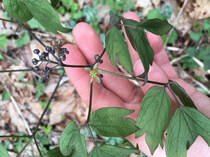
There is nothing quite like the first flush of spring. To me, it is a season of familiar surprises. I forget the crocuses will bloom, then suddenly they are there, and even the crisp March air feels warmer with the promise of renewal. Other bulbs begin to pop up in garden beds, the maples and sassafras put out cheery colored tassels, the pear trees downtown make a smell that’s horrible but worth it for the resulting display, and in the woods covering the mountains, precious spring ephemerals carry out their fleeting cycles.
I remember my first real experience of spring in Appalachia like a dream, because in some ways it was. I had lived here for two and a half years already, but working multiple jobs outside my own studio had kept me tethered to the realms of work and home, with almost no time for exploration in my exhausted hours off. The previous summer had been marked by the end of a significant relationship, and I was struggling to recalibrate my life and goals. Then in March of 2020, I was laid off from my restaurant job. What began as a period of uncertainty developed into one of the best things that has happened in my life: a total transition to self employment and the freedom to chart a course in a new direction. During that spring I spent more time in my studio than I had been afforded in years, had time for cooking and gardening projects, and made up for lost time being outdoors. Most importantly, I began to make time for self reflection.
I remember my first real experience of spring in Appalachia like a dream, because in some ways it was. I had lived here for two and a half years already, but working multiple jobs outside my own studio had kept me tethered to the realms of work and home, with almost no time for exploration in my exhausted hours off. The previous summer had been marked by the end of a significant relationship, and I was struggling to recalibrate my life and goals. Then in March of 2020, I was laid off from my restaurant job. What began as a period of uncertainty developed into one of the best things that has happened in my life: a total transition to self employment and the freedom to chart a course in a new direction. During that spring I spent more time in my studio than I had been afforded in years, had time for cooking and gardening projects, and made up for lost time being outdoors. Most importantly, I began to make time for self reflection.
Each Sunday I would head up to the Blue Ridge Parkway and hike sections of the Mountains to Sea Trail. One section in particular I visited almost every week, to watch the progression of spring flowers and foliage into the summer. It was during this time that I fell in love with spring ephemerals. I remember wanting to shout out loud the first time I came across a wake robin, and my awe upon coming into a glade carpeted entirely with trout lilies, so numerous it was hard to avoid stepping on them on the trail. I can recall my curiosity upon discovering the strange, rubbery purplish stalks of early blue cohosh with its leaves still folded in, followed by a slightly manic hunt to find a flowering specimen after finally identifying the plant with the help of a friend. Watching these flowers emerge was a metaphor for what was happening in myself; new buds full of the promise of life were pushing up after feeling like I had spent a long winter underground.
Those hikes and their discoveries marked the first time I had felt joyful in a long time, and I knew that I wanted to make pots decorated with spring ephemerals to commemorate that feeling. Because though the flowers are ephemeral, the feeling is eternal, and universal: the whole of creation seems to rise up with renewed vigor when the earth turns green again.
Perhaps my favorite word for this phenomenon is viriditas, used extensively in the writing and music of Hildegard of Bingen, a 12th century saint, mystic, composer, and scholar of medieval medicine. Hildegard referred to viriditas as a “greening force” within all living things. She wrote of the connection between health and spirituality, detailing both the uses of foods and herbs with “good viriditas” and the cultivation of positive virtues as a way to achieve holistic health. Just as the trees put forth new leaves, we are invited to join in with all of nature in the cycles of growth and renewal. Hildegard’s viriditas describes nothing less than a divine life force coursing through all the earth, and the color green is an expression of the joy to be a part of it.
Perhaps my favorite word for this phenomenon is viriditas, used extensively in the writing and music of Hildegard of Bingen, a 12th century saint, mystic, composer, and scholar of medieval medicine. Hildegard referred to viriditas as a “greening force” within all living things. She wrote of the connection between health and spirituality, detailing both the uses of foods and herbs with “good viriditas” and the cultivation of positive virtues as a way to achieve holistic health. Just as the trees put forth new leaves, we are invited to join in with all of nature in the cycles of growth and renewal. Hildegard’s viriditas describes nothing less than a divine life force coursing through all the earth, and the color green is an expression of the joy to be a part of it.

For me, observing those spring ephemerals pushing their green stalks and delicate flowers up through the matted carpet of last year’s dead leaves evokes that same feeling of happiness to be alive and a part of something greater than oneself. Each of those blooms seems to me a small miracle, a reminder that life is something special and sacred to be cherished. I feel Hildegard’s viriditas taking hold of both my studio practice and my inner life as we enter this spring. This collection of pottery is in a new colorway, with new forms, and new plant designs painted on them! It feels fresh in a way that my work has not felt for some time, a direct result of cultivating a greening force in my own mind and spirit, and I think it shows in the pieces.

The images in this post are a sampling from my first round of Spring Ephemeral pots in new shades of green. I love the variation that the wood kiln provides depending on where the pots are placed. Some get more ash deposited on them, some more salt, and the level of reduction in the kiln affects color as well. No matter where they were, each of the shades of green is pleasing to me, evoking the color of rich woods and verdant leaves. I am working on the rest of the collection now: an assortment of pots for everyday use as well as pieces for special occasions and places of prominence. All of the pieces will be painted with the delicate spring ephemerals so beloved in our mountain ecosystem. I will announce the date of the sale in my email newsletter and on my instagram, so sign up or follow along to get first pick of these special pots!
Perhaps these pots will call to mind familiar friends whose names you know well: bloodroot, trillium, trout lily, and the like. Or maybe they'll invite you to take your mug outdoors and enjoy the spring air after a winter spent inside. To me, these pieces commemorate the special experience of discovering something new in the earth and in the self.
I hope that while using these pots, you are filled with viriditas my friends!
Perhaps these pots will call to mind familiar friends whose names you know well: bloodroot, trillium, trout lily, and the like. Or maybe they'll invite you to take your mug outdoors and enjoy the spring air after a winter spent inside. To me, these pieces commemorate the special experience of discovering something new in the earth and in the self.
I hope that while using these pots, you are filled with viriditas my friends!
Viriditas
St. Hildegard of Bingen (1098-1179)
translated by Gabriele Uhlein
I am the one whose praise
echoes on high.
I adorn all the earth.
I am the breeze that nurtures all things
green.
I encourage blossoms to flourish
with ripening fruits.
I am led by the spirit to feed
the purest streams.
I am the rain
coming from the dew
that causes the grasses to laugh
with the joy of life.
I call forth tears.
I am the yearning for good.
St. Hildegard of Bingen (1098-1179)
translated by Gabriele Uhlein
I am the one whose praise
echoes on high.
I adorn all the earth.
I am the breeze that nurtures all things
green.
I encourage blossoms to flourish
with ripening fruits.
I am led by the spirit to feed
the purest streams.
I am the rain
coming from the dew
that causes the grasses to laugh
with the joy of life.
I call forth tears.
I am the yearning for good.







 RSS Feed
RSS Feed